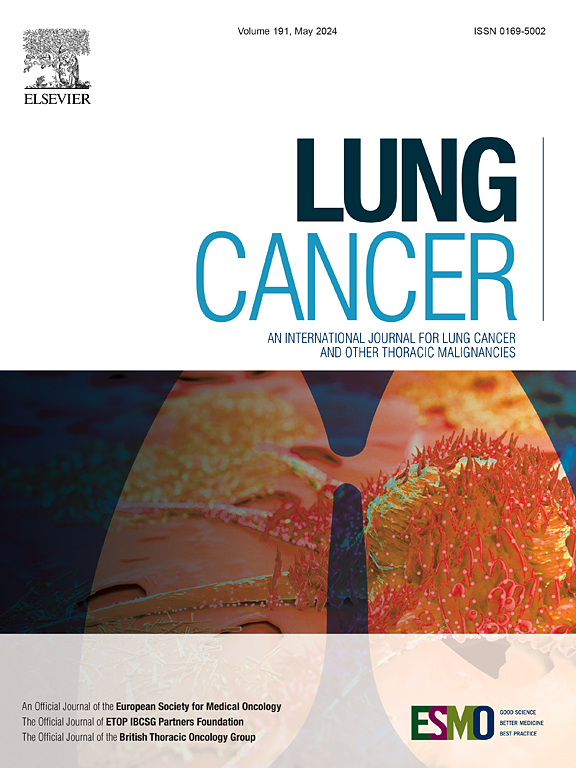表皮生长因子受体靶向疗法原发性耐药的可能机制:回顾性研究
IF 4.5
2区 医学
Q1 ONCOLOGY
引用次数: 0
摘要
背景表皮生长因子受体(EGFR)突变的晚期肺腺癌(LUAD)患者通常会对一线表皮生长因子酪氨酸激酶抑制剂(EGFR-TKIs)治疗产生耐药性。然而,原发性耐药的机制和生物标志物仍不清楚。该研究涉及124名携带常见致敏表皮生长因子受体突变(19外显子缺失或L858R突变)并接受EGFR-TKIs一线治疗的IV期LUAD患者。所有参与者都接受了基线样本的DNA靶向测序检测,其中19名患者的无进展生存期(PFS)≤3个月(队列1,C1,原发性耐药),22名患者的无进展生存期(PFS)≤3个月(队列2,C2,不良反应),83名患者的无进展生存期(PFS)≥8个月(队列3,C3,正常)。结果在整个研究人群中,治疗前患者基线最常见的突变基因是TP53(65%)、MYC(19%)、CDKN2A(12%)、MUC16(12%)和RBM10(12%)。除了C1和C2中表皮生长因子受体(EGFR)L858R突变和19号外显子缺失的患者比例高于C3(P = 0.036)外,各组间的基线特征无显著差异。C1是主要耐药组,其PIK3C2G、STK11、EPAS1、RARA和BTG2变异频率明显较高。多变量 Cox 分析显示,PIK3C2G(HR 15.70,95 % CI 3.24-76.05,p <0.001)、STK11(HR 17.04,95 % CI 3.68-78.92,p <0.001)、EPAS1(HR 11.99,95 % CI 2.57-56.03,p = 0.002)和 BTG2 扩增(HR 9.53,95 % CI 1.67-54.28,p = 0.011)与较短的 PFS 显著相关。这些信息有助于深入了解携带表皮生长因子受体突变的不同 LUAD 患者的分子变化及其对临床治疗的影响。本文章由计算机程序翻译,如有差异,请以英文原文为准。
Putative mechanisms of primary resistance to EGFR-targeted therapies: A retrospective study
Backgrounds
Advanced lung adenocarcinoma (LUAD) patient with EGFR mutations often experience resistance to first-line epidermal growth factor tyrosine kinase inhibitors (EGFR-TKIs) therapy. Nonetheless, the mechanism and biomarkers of primary resistance remain unclear. Further exploration of independent prognostic factors will help clinicians identify patients who may not respond to EGFR-TKIs and select appropriate treatment strategies.
Methods
A retrospective study involving 124 patients with stage IV LUAD harboring a common sensitizing EGFR mutation (exon 19 deletion or L858R mutation) who received EGFR-TKIs as first-line therapy was performed. All participants were tested by DNA-targeted sequencing in baseline samples, and there were 19 patients with progression-free survival (PFS) ≤ 3 months (cohort 1, C1, primary resistance), 22 patients with 3 < PFS < 8 months (cohort 2, C2, poor response) without known mutations associated with resistance, and 83 patients with PFS ≥ 8 months (cohort 3, C3, normal).
Results
The most commonly mutated genes at baseline in patients prior to treatment within the entire study population. were TP53 (65 %), MYC (19 %), CDKN2A (12 %), MUC16 (12 %) and RBM10 (12 %). The baseline characteristics, except for the proportions of patients with EGFR L858R mutation and exon 19 deletion in C1 plus C2 compared to C3 (p = 0.036), were not significantly different among the cohorts. The frequencies of PIK3C2G, STK11, EPAS1, RARA and BTG2 variation were significantly higher in C1, the primary resistance group. Multivariate Cox analysis revealed that PIK3C2G (HR 15.70 95 % CI 3.24–76.05, p < 0.001), STK11 (HR 17.04, 95 % CI 3.68–78.92, p < 0.001), EPAS1 (HR 11.99, 95 % CI 2.57–56.03, p = 0.002), and BTG2 amplification (HR 9.53, 95 % CI 1.67–54.28, p = 0.011) were significantly associated with shorter PFS.
Conclusions
The genomic landscape varies significantly among patients with LUAD, which should be considered when making personalized treatment decisions. This information could provide insights into molecular changes and their effects on clinical treatment in diverse patients with LUAD harboring sensitizing EGFR mutations.
求助全文
通过发布文献求助,成功后即可免费获取论文全文。
去求助
来源期刊

Lung Cancer
医学-呼吸系统
CiteScore
9.40
自引率
3.80%
发文量
407
审稿时长
25 days
期刊介绍:
Lung Cancer is an international publication covering the clinical, translational and basic science of malignancies of the lung and chest region.Original research articles, early reports, review articles, editorials and correspondence covering the prevention, epidemiology and etiology, basic biology, pathology, clinical assessment, surgery, chemotherapy, radiotherapy, combined treatment modalities, other treatment modalities and outcomes of lung cancer are welcome.
 求助内容:
求助内容: 应助结果提醒方式:
应助结果提醒方式:


